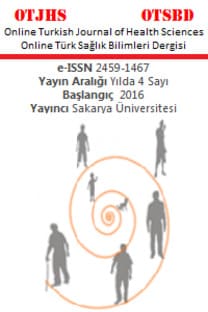Pediatrik Hastalarda Postoperatif Dönemde Ağrı ve Deliryumu Ayırt Etmede FLACC ve OPS Ölçeklerinin Karşılaştırılması
ağrı, FLACC skalası, OPS skalası, PAED skalası, deliryum
The Comparison of FLACC and OPS Scales in Differentiating Pain and Emergence Delirium in the Postoperative Period in Pediatric Patients
Pain, delirium, FLACC scale, OPS scale, PAED scale,
___
- Holly MacDonell. Emergence Delirium: Causation, Correlation and Improvements Needed. EC Pulmonology and Respiratory Medicine. 2019;8:623-629.
- Wong DDL, Bailey CR. Emergence delirium in children. Anaesthesia. 2015;70(4):383–387.
- Bajwa S, Fanzca DC, Drcog AMC. A comparison of emergence delirium scales following general anaesthesia in children. Paediatr Anaesth. 2010;20:704-711.
- Sikich N and Lerman J. Development and psychometric evaluation of the pediatric anaesthesia emergence delirium scale. Anesthesiology. 2004;100:1038-1045.
- Pancekauskaitė G, Jankauskaitė L. Paediatric Pain Medicine: Pain Differences, Recognition and Coping Acute Procedural Pain in Paediatric Emergency Room. Medicina (Kaunas). 2018;54(6):94. doi:10.3390/medicina54060094
- Buttner W, Finke W, Büttner W, Finke W. Analysis of Behavioural and Physiological Parameters for the Assessment of Postoperative Analgesic Demand in Newborns, Infants and Young Children: A Comprehensive Report on Seven Consecutive Studies. Paediatr Anaesth. 2000;10:303–318. doi: 10.1046/j.1460-9592.2000.00530.x
- Merkel SI, Voepel-Lewis T, Shayevitz JR, Malviya S. The FLACC: A behavioral scale for scoring postoperative pain in young children. Pediatr Nurs. 1997;23:293–297.
- Broadman LM, Rice LJ, Hannallah RS. Testing the validity of an objective pain scale for infants and children. Anesthesiology. 1988;69:A770.
- Somaini M, Engelhardt T, Fumagalli R, et al. Emergence delirium or pain after anaesthesia–how to distinguish between the two in young children: a retrospective analysis of observational studies. Br J Anaesth. 2016;116:377–383.
- Tuomilehto H, Kokki H, Ahonen R, Nuutinen J. Postoperative Behavioral Changes in Children After Adenoidectomy. Arch Otolaryngol Head Neck Surg. 2002;128(10):1159–1164. doi:10.1001/archotol.128.10.1159
- Lee CA. Paediatric emergence delirium: an approach to diagnosis and management in the postanaesthesia care unit. Perioper Crit Intensive Care Nurs. 2017;3:140. doi:10.4172/2471-9870.10000140
- Somaini M, Sahillioğlu E, Marzorati C, Lovisari F, Engelhardt T, Ingelmo PM. Emergence delirium, pain or both? A challenge for clinicians. Paediatr Anaesth. 2015;25(5):524-529. doi:10.1111/pan.12580
- Aldakhil SK, Salam M, Albelali AA, Alkanhal RM, Alnemer MJ, Alatassi A. The prevalence of emergence delirium and its associated factors among children at a postoperative unit: A retrospective cohort at a Middle Eastern hospital. Saudi J Anaesth. 2020;14(2):169-176. doi:10.4103/sja.SJA_573_19
- Mehrotra S. Postoperative anaesthetic concerns in children: Postoperative pain, emergence delirium and postoperative nausea and vomiting. Indian J Anaesth. 2019;63(9):763-770. doi:10.4103/ija.IJA_391_19
- Nair S, Wolf A. Emergence delirium after paediatric anaesthesia: new strategies in avoidance and treatment. BJA Education. 2018;18(1):30-33.
- Mohkamkar M, Farhoudi F, Alam-Sahebpour A, Mousavi SA, Khani S, Shahmohammadi S. Postanesthetic Emergence Agitation in Pediatric Patients under General Anesthesia. Iran J Pediatr. 2014;24(2):184-190.
- Kain ZN, Caldwell-Andrews AA, Maranets I. Preoperative anxiety and emergence delirium and postoperative maladaptive behaviors. Anesthesia & Analgesia. 2005;99(6):1648-54.
- ISSN: 2459-1467
- Yayın Aralığı: Yılda 4 Sayı
- Başlangıç: 2016
- Yayıncı: Oğuz KARABAY
Mehtap BİNGÜL, Duygu SÖMEN BAYOĞLU, Tamay GÜRBÜZ, Pınar ALAGÖZ, Sebahat AKSARAY, Çağatay NUHOĞLU
Bilateral Senkronize Over Torsionlu Bebek Hasta
Aytaç TAŞÇI, Hasan ARIK, Güleç MERT DOĞAN
Nanoteknoloji ve Nanobiyomalzemeler: Ağız Kanserini Yönetme Yollarını Yeniden Tanımlama
Ortodontiye İlişkin Dünya Genelindeki İnternet Verilerinin Değerlendirilmesi: Google Trends Analizi
Muhammed Hilmi BÜYÜKÇAVUŞ, Burak KALE, Hikmet ORHAN
COVID-19 Pozitif Hastaya Hemşirelik Bakımı Veren Bir Hemşirenin Deneyimleri: Olgu Sunumu
Canan BİRİMOĞLU OKUYAN, Elifnur GÜNEŞ, Esra YEŞİLYURT
Youtube ve Astım: Astımla İlgili Popüler Videoların Bilgi İçeriğinin Eleştirel Bir Değerlendirmesi
Fatma Esra GÜNAYDIN, Sedat ALTIN
Ezgi Gamze BURUNSUZ, SELMİN KÖSE
Lomber Spinal Stenozun HLA İlişkisi Üzerine Ön Araştırma
Mustafa EFENDİOĞLU, Ezgi AKAR, Emine Emel KOÇMAN, Recep BAŞARAN, Gülbu IŞITMANGİL
Riskli Gebelerde Prenatal Bağlanma ve Risklerin Değerlendirilmesi
